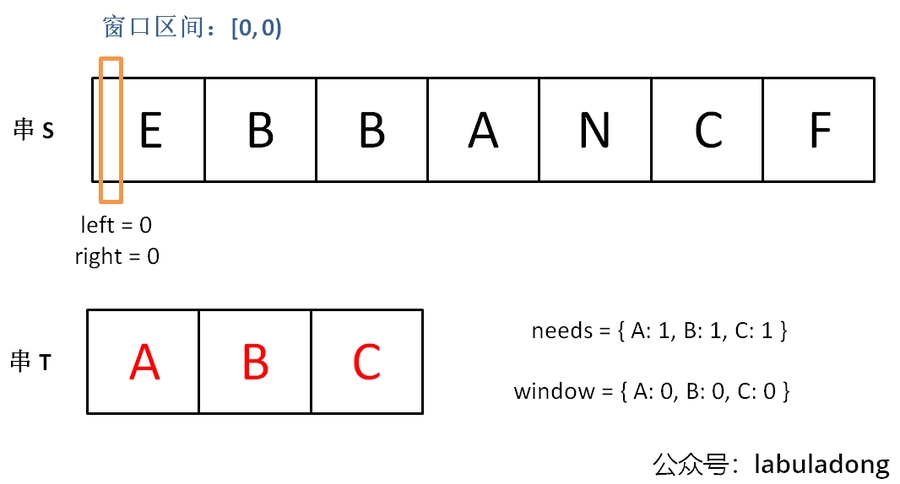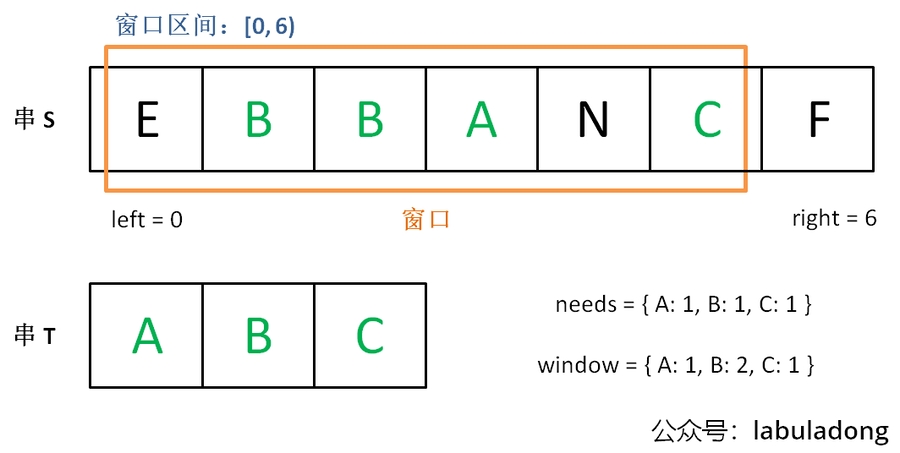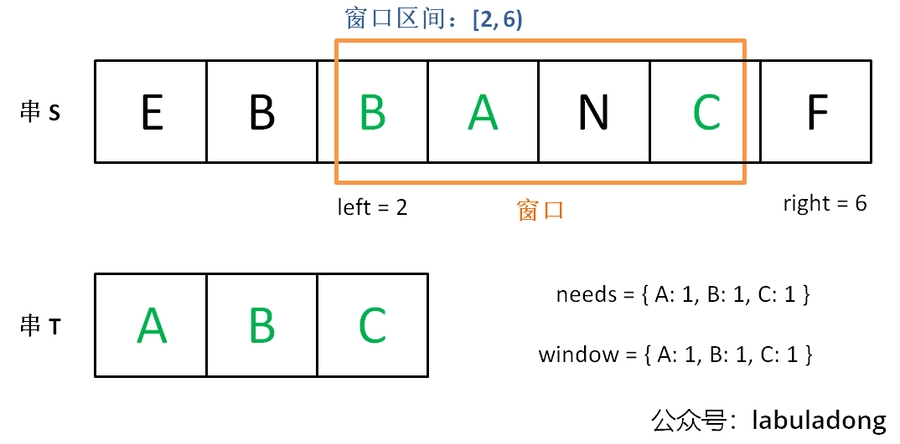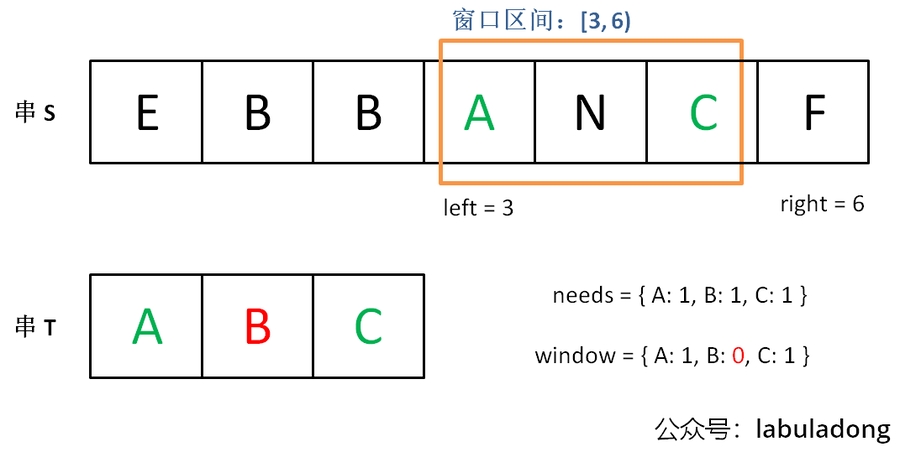76. Minimum Window Substring(H)
https://leetcode.com/problems/minimum-window-substring/
Given two strings s and t of lengths m and n respectively, return the minimum window substring of s such that every character in t (including duplicates) is included in the window. If there is no such substring, return the empty string "".
The testcases will be generated such that the answer is unique.
A substring is a contiguous sequence of characters within the string.
Example 1:
Input: s = "ADOBECODEBANC", t = "ABC"
Output: "BANC"
Explanation: The minimum window substring "BANC" includes 'A', 'B', and 'C' from string t.Example 2:
Input: s = "a", t = "a"
Output: "a"
Explanation: The entire string s is the minimum window.Example 3:
Input: s = "a", t = "aa"
Output: ""
Explanation: Both 'a's from t must be included in the window.
Since the largest window of s only has one 'a', return empty string.
Constraints:
m == s.lengthn == t.length1 <= m, n <= 105sandtconsist of uppercase and lowercase English letters.
Follow up: Could you find an algorithm that runs in O(m + n) time?
Solution:
https://www.jiuzhang.com/solution/minimum-window-substring/
就是说要在 S(source) 中找到包含 T(target) 中全部字母的一个子串,且这个子串一定是所有可能子串中最短的。
如果我们使用暴力解法,代码大概是这样的:
思路很直接,但是显然,这个算法的复杂度肯定大于 O(N^2) 了,不好。
滑动窗口算法的思路是这样:
1、我们在字符串 S 中使用双指针中的左右指针技巧,初始化 left = right = 0,把索引左闭右开区间 [left, right) 称为一个「窗口」。
2、我们先不断地增加 right 指针扩大窗口 [left, right),直到窗口中的字符串符合要求(包含了 T 中的所有字符)。
3、此时,我们停止增加 right,转而不断增加 left 指针缩小窗口 [left, right),直到窗口中的字符串不再符合要求(不包含 T 中的所有字符了)。同时,每次增加 left,我们都要更新一轮结果。
4、重复第 2 和第 3 步,直到 right 到达字符串 S 的尽头。
这个思路其实也不难,第 2 步相当于在寻找一个「可行解」,然后第 3 步在优化这个「可行解」,最终找到最优解,也就是最短的覆盖子串。左右指针轮流前进,窗口大小增增减减,窗口不断向右滑动,这就是「滑动窗口」这个名字的来历。
下面画图理解一下,needs 和 window 相当于计数器,分别记录 T 中字符出现次数和「窗口」中的相应字符的出现次数。
初始状态:
增加 right,直到窗口 [left, right] 包含了 T 中所有字符:
现在开始增加 left,缩小窗口 [left, right]:
直到窗口中的字符串不再符合要求,left 不再继续移动:
之后重复上述过程,先移动 right,再移动 left…… 直到 right 指针到达字符串 S 的末端,算法结束。
如果你能够理解上述过程,恭喜,你已经完全掌握了滑动窗口算法思想。现在我们来看看这个滑动窗口代码框架怎么用:
首先,初始化 window 和 need 两个哈希表,记录窗口中的字符和需要凑齐的字符:
然后,使用 left 和 right 变量初始化窗口的两端,不要忘了,区间 [left, right) 是左闭右开的,所以初始情况下窗口没有包含任何元素:
其中 valid 变量表示窗口中满足 need 条件的字符个数,如果 valid 和 need.size 的大小相同,则说明窗口已满足条件,已经完全覆盖了串 T。
现在开始套模板,只需要思考以下四个问题:
1、当移动 right 扩大窗口,即加入字符时,应该更新哪些数据?
2、什么条件下,窗口应该暂停扩大,开始移动 left 缩小窗口?
3、当移动 left 缩小窗口,即移出字符时,应该更新哪些数据?
4、我们要的结果应该在扩大窗口时还是缩小窗口时进行更新?
如果一个字符进入窗口,应该增加 window 计数器;如果一个字符将移出窗口的时候,应该减少 window 计数器;当 valid 满足 need 时应该收缩窗口;应该在收缩窗口的时候更新最终结果。
下面是完整代码:
PS:使用 Java 的读者要尤其警惕语言特性的陷阱。Java 的 Integer,String 等类型判定相等应该用
equals方法而不能直接用等号==,这是 Java包装类的一个隐晦细节。所以在左移窗口更新数据的时候,不能直接改写为window.get(d) == need.get(d),而要用window.get(d).equals(need.get(d)),之后的题目代码同理。
需要注意的是,当我们发现某个字符在 window 的数量满足了 need 的需要,就要更新 valid,表示有一个字符已经满足要求。而且,你能发现,两次对窗口内数据的更新操作是完全对称的。
当 valid == need.size() 时,说明 T 中所有字符已经被覆盖,已经得到一个可行的覆盖子串,现在应该开始收缩窗口了,以便得到「最小覆盖子串」。
移动 left 收缩窗口时,窗口内的字符都是可行解,所以应该在收缩窗口的阶段进行最小覆盖子串的更新,以便从可行解中找到长度最短的最终结果。
至此,应该可以完全理解这套框架了,滑动窗口算法又不难,就是细节问题让人烦得很。以后遇到滑动窗口算法,你就按照这框架写代码,保准没有 bug,还省事儿。
Last updated
Was this helpful?



